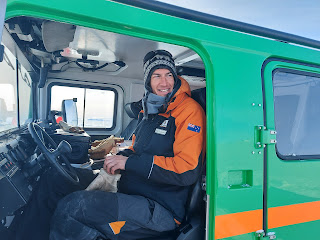Training: First full day in Antarctica
A pretty full-on first full day. Quite the introduction for the four team members who haven't been to Antarctica before!
First up at 8.15 am, health check #1... In an effort to control and manage covid at Scott Base, not only has everyone been required to pass a PCR 72 hours prior to flying south, and a RAT on the morning of departure, we are all required to undergo a series of checks and tests over the first week. We'll have check-ins with the base medic on days 1, 3, 5, and 7; we'll have to complete a RAT on day 3; and test negative on a PCR before heading out to the field. Attempting to manage and isolate a covid case while at Scott Base will be hard enough as it is... It would have to be nigh on impossible in the isolation of a field camp.
Then it was time for our 'In Brief'. This is where we catch up with key representative members of the Scott Base team to go through our plans, changes to plans (already quite significant with the delays so far), resource and training needs, and any other issues that may arise. This was a really good discussion - it's so great to get to know the team here and find that everyone just wants to do whatever is needed to make the science happen!
Straight out of the In Brief room to begin AFT (Antarctic Field Training) with Jude and Philly. Today was going over the 'basic' or fundamental skills for survival, and we'll have more training that's tailored to our needs once we get to camp. So today we talked through the main hazards and how to avoid and/or manage them. Interestingly, 'slips, trips, and falls' plague Antarctic work just as much as anywhere and are the main sources of injury here. As well, of course, we need to be aware of the specific dangers of cold weather - frost nip, frost bite, hypothermia - and how quickly a lovely sunny day like today can quickly turn bad, just with the addition of wind.
Jude then had us go through the 'survival bags' to make sure we understood the contents and what they're for. We don't travel anywhere off base without taking the appropriate number of survival bags, depending on the number in the party. They come in two sizes - single and double - with the main difference being the size of the tent. In order to pass our AFT, we also need to light the cooking stoves. In our case, these will only come out in a survival situation, so it's really valuable to do this again each year to make sure that it stays fresh in our minds.
After lunch it was time for Hagglunds training. These are the tracked all-terrain two-cab vehicles that are one of two primary means of transport on the sea ice (the other being skidoos AKA snowmobiles). First job was to have Dave (the SB mechanic) walk us around the vehicle identifying all the tasks we need to complete before setting off - it's a little more complicated than hopping into a car back home! Typically, the engine needs to run for 20 minutes before it's OK to drive, and in some cases we have to use a separate heater to warm the engine before we even turn in on to idle!
Then it was time to take the Hagglunds for a spin. Dave drove us down onto the sea ice, then Jacqui, Ollie, and Craig took it in turns to try out various manoeuvres that we might need use: driving forwards in high and low gear, turning in a circle (the rear cab has independent steering), reversing, and finally hitching up a sled. Driving a Hagglunds here is a pretty important skill, but it's also a heap of fun. Here you can see Ollie grinning from ear to ear behind the wheel of H8.




Comments
Post a Comment